

Buzzword Decoder: Content Curation by Pamela S. Hogle: Page 2. Marc My Words: From Content Creation to Content Curation: The Importance of Curation by Marc Rosenberg: Page 2. The curation challenge The Internet is a terrific knowledge repository.

The sheer size of the content stored on the web is unimaginable. And, within organizational intranets, the amount of content that is available is similarly impressive. But is it good content? Is it the right content for the right purpose? Content curation focuses on the accuracy, relevance, usefulness, value, and other aspects of knowledge assets. Let’s not forget the issues of design, organization, navigation, and usability. A checklist to get started So assuming people can find the content, the question is, was the search beneficial? Use these problem identifiers as a beginning checklist for evaluating the content you are posting online. 5 Tips To Use The Plutchik’s Wheel Of Emotions In eLearning - eLearning Industry. Robert Plutchik, a noted professor and psychologist, developed the Wheel of Emotions in the 1980’s.
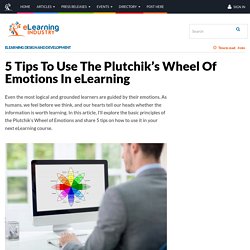
At the time, Plutchik wanted to provide a visual representation of the psychoevolutionary theory. However, since its inception the wheel has been used by writers, therapists, and educators alike to understand the delicate balance of human emotions. The Wheel of Emotions looks much like a traditional color wheel, and features 8 primary emotions that grow in intensity as you move into the center of the diagram. For example, joy falls in between serenity, which is a lighter color found on the outer ring of the wheel, and ecstasy, which is darker and at the center of the diagram. eLearning professionals can use this wheel to develop powerful and engaging eLearning courses by connecting with their learners at an emotional level. Top 3 Reasons Leadership Training Fails to Change Behavior. Since 2010, investments in leadership training have grown significantly, now surpassing $14 billion in the US alone.However, despite these increased expenditures, 86% of global HR and business leaders still say that leadership development remains a top issue for their organizations.
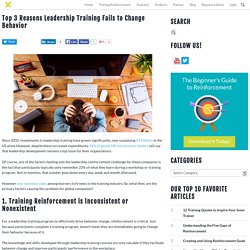
Of course, one of the factors feeding into the leadership reinforcement challenge for these companies is the fact that participants typically only remember 23% of what they learn during a workshop or training program. Not to mention, that number goes down every day, week and month afterward. Welcome! Screencast-O-Matic.
Plickers. Global Microlearning Survey [Infographic] 5 Instructional Design Tips To Enhance Metacognition In eLearning. An empowered learner is a successful learner.
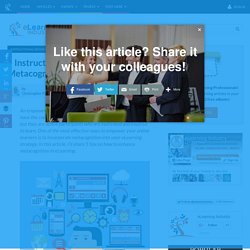
Not only do they have the confidence they need to solve problems autonomously, but they are active participants who are motivated and inspired to learn. One of the most effective ways to empower your online learners is to incorporate metacognition into your eLearning strategy. In this article, I’ll share 5 tips on how to enhance metacognition in eLearning. Metacognition involves not just having knowledge and being able to cognitively process information, but being able to control these mental processes.
This typically involves modification, monitoring, and organization of the information in order to apply it in real world settings. One of the most significant advantages of using metacognition in eLearning is that it encourages learners to become more independent and empowered. Metacognitive Knowledge vs. Microlearning Training Videos. Storyboarding: Key Point Of Success In Collaborative Course Authoring. In part 1 of the article Storyboarding: A Simple Way To Get Professional In Course Authoring we took a look at storyboards, their purpose, and the best ways to start working with them.
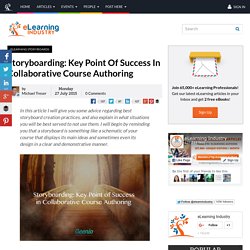
Creating a storyboard makes working on a course significantly easier, and enables you to identify weak spots in your course and fix them on the fly. And like in any other human endeavor, there are many nuances and tricks to creating storyboards, and knowing them can save you a lot of time and effort. As you have probably guessed, this is what the second part of the article will be about; bringing people who have never created a storyboard in their life up to speed.
No need to make the same mistakes thousands of eLearning pros have already learned from before you, right? Lucky for you, they are a pretty cool bunch, and are ready to share. Elearningindustry. If you’re looking for a way to make your eLearning courses more interactive, immersive, and empowering for your learners, then read this article on how eLearning professionals could enrich their eLearning courses using a project-based learning approach.
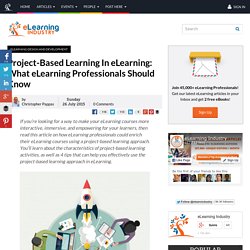
Top 10 Text To Speech (TTS) Software For eLearning. There are several reasons why you should consider using text to speech software for your eLearning courses; converting words into speech accommodates learning difficulties, develops speech and literacy skills, and allows for different paces to work with.

In this article I will share the best text to speech software for eLearning, so that you can be able to explore your options and select the right text to speech software for you. Todd sur Twitter : "Try case-based learning as your eLearning tool. #learningmanagments... CaseSwarm - Infographic: Businesses Love Tablets and Video.
Sponge elearning sur Twitter : "Find out how elearning courses can simplify learning: #learningatworkweek @LAWWeekWire. How eLearning Courses Can Simplify Learning - eLearning Industry. Non-Linear eLearning Design: 6 Common Misconceptions Instructional Designers Should Know. Although the concept of non-linearity in eLearning course design may seem straightforward, misconceptions about non-linearity in instructional design are common.

In this article, I’ll discuss some common misconceptions about non-linearity, as well as the fact that, in most cases, instructional designers follow a mixed approach, including both linear and non-linear elements. Nowadays, eLearning professionals are eager to keep up-to-date with latest trends in instructional design for their eLearning courses. Most of them tend to follow the general rule-of-thumb, that the more interactive an eLearning course is and the more non-linear its instructional design is, the better. This tendency, however, has initiated some confusion to non-instructional designers who tend to identify interactivity with non-linearity. In fact, non-linearity refers to learners’ freedom of choice with respect to the order in which eLearning course items, information or activities, are presented on screen. 5 Tips To Develop Mobile Learning Assessments.
Mobile learning can take place anywhere, anytime, thanks to mobile devices.
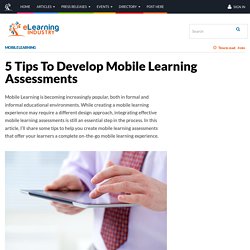
Learners can now access educational resources whenever they find most convenient and engage in powerful mobile learning experiences while on-the-go. However, mobile learning courses can only be truly effective if there is a way to assess learners knowledge and determine whether they have actually absorbed and retained the subject matter. Here are some helpful tips to develop mobile learning assessments for your next mobile learning course. Conclude each unit or module with an assessment. Provide learners with an assessment at the end of each unit or module rather than just integrating one at the very end of the mobile learning course. Cognitive Load Theory: What You Need to Know to Develop Instructional Tools that Work. A central piece in the puzzle of designing instructional tools is understanding how the human mind learns—how much information can a learner retain, and how should that information be presented?

Investment costs in the design, production, and implementation of e-learning in particular makes the effectiveness of such tools even more crucial. A poorly designed course can confuse learners, missing the instructional mark and costing your company dearly. What you need to consider is cognitive load—in other words, how much effort your learners need to spend to really absorb your content. In the 1980s, psychologist John Sweller came up with a framework for cognitive load. Arcsmode.ipower.com. This Is Why You Should Take Notes By Hand Instead Of With A Laptop. If you walk into any lecture these days, you see a majority of students staring at their screens. You hear a never-ending chorus of pounding keys. Yes, we live in digital age and I bet you can’t imagine not using your laptop for studying. Yes, laptops enable you to do more academic work and do it more efficiently. Creating Simulations for e-Learning in Healthcare. In the healthcare field, clinical simulations are often used to teach or provide additional training.
To increase competency, the simulations focus on the learner’s experience to solve problems, perform skills and make determinations. Studies have shown that simulations can result in increased confidence and better clinical judgment. Incorporating virtual interactions into these lessons will enhance the value of the clinical simulation. 'Death by PowerPoint' and Other Sales Training Fails [Infographic] Earlier this year I was at an annual two-day sales training event for a global software company. The venue, meals and entertainment had been painstakingly planned to ensure everyone had a memorable time.
Unfortunately the actual training portion of the event was not so memorable. Based on roles, tenure and a self-assessment, each sales team member was given a curriculum of mandatory training classes to attend. External experts as well as internal employees from product marketing, sales enablement, marketing and sales operations taught the classes. The goal was to improve sales productivity and achieve a target level of skill consistency across geographic regions. According to the senior director of sales training, “Curriculums provide personalized training paths so each person builds the right skills they need to be successful.” The whole training event sounded great on paper except that it lacked a key ingredient: how sales wants to consume information.
Wake Up, Please Going Mobile. Social Learning Handbook 2014. A center for research into Self-Organized Learning. Students at a School in the Cloud lab in India investigate a big question on their own in a SOLE. At the newly-opened SOLE Central at Newcastle University, research will be conducted on this type of learning. Photo: School in the Cloud Picture a classroom teacher without a lesson plan — a teacher who instead asks students an open-ended question to explore: Can animals think? Did dinosaurs exist? Curation: A Core Competency for Learning Professionals. In my first two posts for Learning Circuits, I explored how I use Twitter as a professional development tool, and last week we looked at Filtering: A Challenge and Responsibility for Learning Professionals.
This week we're going to explore filtering further, and explain how learning professionals will provide filtering services on an increasing basis. There are two primary ways that filtering will impact learning professionals. Top 10 FREE Plagiarism Detection Tools for Teachers. Editor's note: We have originally written and published this article in November 2013. Thanks to your useful suggestions and our own following of the latest developments in the fast paced field of technology, we have updated this piece in October 2015 in the hope that you will keep finding it useful.
Thank you for sharing! The act of taking someone else’s ideas and passing them off as your own defines the concept of “plagiarism”. As it is shown by the growing educational concerns, plagiarism has now become an integral part of our digital lives as technology, with the billions of information it gives us access to, led to the exacerbation of this phenomenon. The Single Secret to Soft Skills « Gerald W. Aungst. Using Webb's Depth of Knowledge to Increase Rigor.
The word "rigor" is hard to avoid today, and it provokes strong reactions from educators. Policymakers tout its importance. Publishers promote it as a feature of their materials. But some teachers share the view of Joanne Yatvin, past president of the National Council for Teachers of English. To them, rigor simply means more work, harder books, and longer school days. How M-learning Can Support Instructor-led Classroom Training. It is estimated that there would be more than 300% increase in tablet shipments, over a period of 5 years, from 2012 to 2017. How to Use The 5 "Moments of Need" Model In Corporate eLearning. How to Record Your Screen and Create Engaging Screencasts. 3 Real-Life Lessons Learned from Difficult On-The-Job Challenges. 3 Real-Life Lessons Learned from Difficult On-The-Job Challenges Posted by Brittany Laeger on Wed, Aug 27, 2014 by Hannah von Bank, relationship management assistant We’ve all made mistakes at work – some more grievous than others.
For every mortified person who has accidentally closed a business call with “I love you” instead of “goodbye,” there is someone else whose slip up could have caused injury, lost someone their job or cost their company millions of dollars. The International Institute Of Directors And Managers. While many people accept the reality of the situation and adjust themselves to what is required, others feel deeply affected at a personal level and resist engaging with the changes.
Dipsticks: Efficient Ways to Check for Understanding. Makeover: How to write challenging scenario questions. One Bite at a Time! Marc My Words: From Interactivity to Engagement by Marc Rosenberg. Marc My Words: From Interactivity to Engagement by Marc Rosenberg. How to maximise free informal learning. Scenario-Based eLearning – Tips for the Adventure. Dos and Don'ts for Project Based Learning. 10 Types of Learners in ELearning. From Training to Performance—A Necessary Evolution. How to Create Open Badge Criteria – Using Competencies. Delivering an effective modernised learning strategy in 2014. How to Make Your Subject Matter Expert a Rockstar! Create Learning Content that Inspires Action. Seven Things eLearning Professionals Must Do Now by Bill Brandon. Make E-learning Easier: The Nature of Knowledge. The How (and Why) It’s Time to Create Digital Student Portfolios. Using Morphological Analysis to Solve Complex eLearning Problems.
Educational Technology and Mobile Learning: A New Wonderful Bloom's Taxonomy Visual for Teachers. How to Use Experiential Course Flow to Enhance eLearning. Scenario Based e-Learning. 70:20:10 – informal learning. Google Tip and Tricks for Conducting Online Research Infographic. Why your Business will see a return on your Investment in Training. Why Is the Research on Learning Styles Still Being Dismissed by Some Learning Leaders and Practitioners? Why You Need a PLN, and How to Develop One: Resources Shared at #LSCon. Emotion In Product Design. eLearning Year in Review: 6 Trends That Dominated 2013 [Infographic] [INFOGRAPHIC] Instructional Design Model: Gagné’s 9 Events of Instruction. 5 Instructional Techniques that Encourage Optimal Learning. Learning Experience As a User Experience — Technkl. Dear Training, It’s Time We Saw Other People. Free Learning Online - Join Us. Storyboard That: The World's Best FREE Online Storyboard Creator.
Learning for organization. Bozarthzone. Lectora - In case you missed it, here's how to apply the... Using Twitter As A Learning Tool.
Game-Based Learning. LMS.